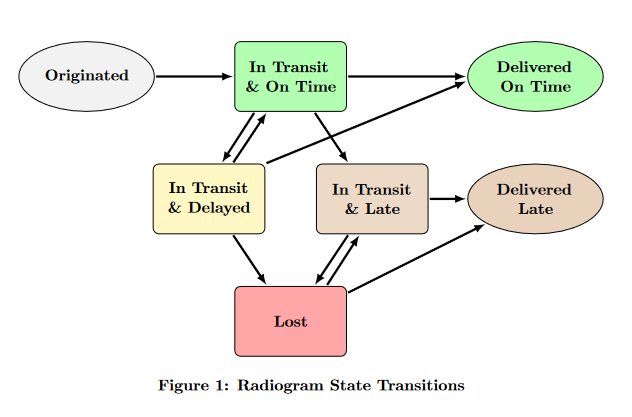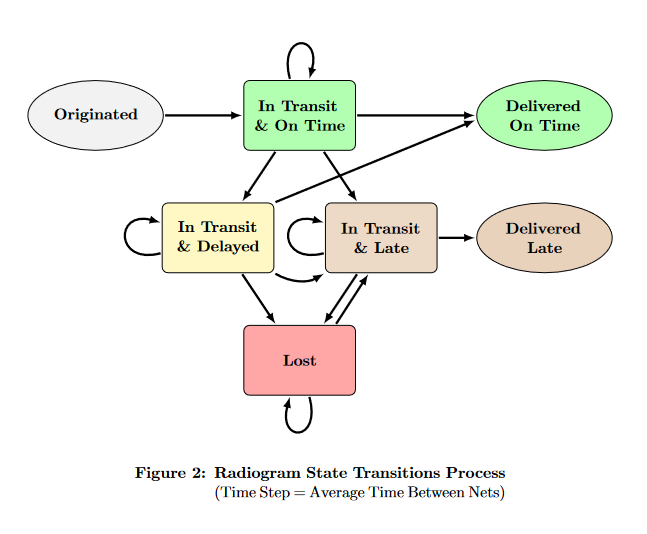Last edit: 8/29/2023
[A PDF version of this document is available for download]
This document lays out the service level objectives for transit and delivery of NTS traffic by message precedence.
Definition of delivery
- Routine: Reasonable belief that the message has or will reach its recipient
- Welfare: Confirmed receipt by the addressee, or voicemail confirms name of recipient
- Emergency, Priority: Confirmed receipt by the addressee
End-to-end transit time
From the time of origination, a Radiogram should be delivered within:
|
Transit time |
|
|
Routine |
5 days |
|
Welfare |
2 days |
|
Priority |
By the next day |
|
Emergency |
30 minutes (HXR recommended) |
A Radiogram delivered after this is considered late.
Relay time
From the time a relay station receives a Radiogram, it should be either further relayed or have a delivery attempt within:
|
Relay time |
|
|
Routine |
2 days |
|
Welfare |
1 day |
|
Priority |
12 hours |
|
Emergency |
See below * |
A Radiogram held longer than this is considered delayed.
* End-to-end transit time limit is 30 minutes. Each individual station must make every effort to see that the traffic moves from end to end through the system within this limit.
Commitment
Even if a service level objective has been missed, the Radiogram is still required to be moved through the system. Any relay station who accepts a Radiogram commits to moving the Radiogram further toward its recipient.
Means of delivery
The following chart illustrates the acceptable means of
delivering a Radiogram, by precedence:
|
Precedence |
Via USPS |
By leaving voicemail |
By sending email/ text-message |
Person to person (or designee) |
|
Routine |
Yes |
Yes |
Yes |
Yes |
|
Welfare |
No |
Yes, if greeting confirms name. |
Yes, if recipient replies with confirmation. |
Yes |
|
Priority |
No |
No |
Yes, if recipient replies with confirmation. |
Yes |
|
Emergency |
No |
No |
No |
Required |
“Person to person” means by real-time two-way communication (phone, text message, radio, in-person, etc.) with the person or another person authorized to receive such messages for that person.
Exception handling
Delivery would incur cost
Description
- Delivery would require toll call or postage
Action (by precedence)
Routine
- HXG specified, Radiogram may be canceled. Service the station of origin.
Welfare/Priority/Emergency
- Must make attempt at delivery, according to chart above.
Insufficient recipient information
Description
- Cannot identify specific recipient, OR
- No contact information: no street address, no phone, no email, no specified traffic net.
Action
- Routine and Welfare: Cancel the message. Service the station of origin.
- Spend time researching contact information for delivery. (Only required for PRIORITY and EMERGENCY.)
- If cannot deliver, service the station of origin as undeliverable with ARL SIXTY SEVEN
Incorrect recipient information
Description
- Recipient information provided, but none is correct. (Bad email, bad phone, etc.)
Action (by precedence)
Routine
- Cancel message and service the station of origin
Welfare/Priority/Emergency
- Service back the issue such as bad phone number (insufficient number of digits) to originator (party in Radiogram signature) and continue relaying towards destination.
- Perform best effort to locate correct recipient contact information
Malformed Radiogram
Description
- Preamble incomplete
- Address, text, or signature block is missing
Action (by precedence)
Routine
- If enough valid information exists to continue relaying, then continue by adding an OP NOTE stating that the Radiogram is malformed.
- If there is not enough valid information to continue relaying, cancel the message and service the station of origin, if able.
- If there is no station of origin provided, cancel the message and no further action is required.
Welfare/Priority/Emergency
- If there is enough valid information to continue relaying, then continue by adding an OP NOTE providing your call sign and a statement that indicates the message is malformed and question its validity.
- E.g. OP NOTE K8AMH RECEIVED MALFORMED MESSAGE FROM (SOURCE)
- If the addressee information is invalid, then cancel the message and service the station of origin if able.
- If no station of origin is specified, begin following SENT/RECEIVED tracking information back towards the station of origin for follow-up.
Delivery is late
Description
Message has not been delivered when the service level objective for end-to-end transit time expires, or when a relay station realizes delivery will be late, whichever occurs first. This may be caused by bad recipient information, for example.
Action (by precedence)
Routine
- Relay or deliver, and service the station of origin noting relay or delivery took place on date/time.
Priority/Welfare/Emergency
- Service the originator (party in Radiogram signature) regarding the situation, and continue attempting to relay or deliver. This gives the originator a chance to attempt a different method or otherwise resolve the issue.
- If after best-effort attempts, relay/delivery is still not possible, cancel the Radiogram and service back to the originator (party in Radiogram signature).
Messages into disaster areas
Description
- Radiogram is bound for a disaster area
Action
Routine/Welfare/Priority
- Follow the direction of leaders within the disaster area. Attempt relay or delivery of the Radiogram, unless instructed otherwise (such as holding a message) by the leaders within the disaster area.
- If held, service the station of origin that the Radiogram will be delayed per guidance by the leaders within the disaster area.
Emergency
- Emergency traffic may not be held and must be moved forward towards its recipient.
Commentary
In large disasters, there are frequently embargoes on inbound non-emergency traffic for 24-72 hours. The reason for that is for the actual emergency traffic to have maximum opportunity to be passed.
Service messages
Service messages should be sent with the same precedence as the original Radiogram.
Reporting
Undeliverable messages should be reported in the station’s Station Activity Report (SAR) in a new UNDELIVERABLE (“U”) field:
- O/# S/# R/# D/# U/# T/#
- ORIGINATE/# SENT/# RECEIVED/# DELIVERED/# UNDELIVERABLE/# TOTAL/#
The total is the sum of Originate, Sent, Received, Delivered, and Undeliverable.
The PSHR category 2 uses this Total (including the Undeliverable count).
The SAR should be updated in a separate effort to include the reasons for the non-deliveries.
Definitions
For the purpose of measuring Service Level Objectives, a Radiogram may fall into one of the following categories:
|
In-transit and on-time |
The Radiogram has not yet been delivered but is within the end-to-end transit time and the relay time for the traffic handler who holds it. |
|
Delivered on-time |
The Radiogram was delivered within the end-to-end transit time. |
|
In-transit and delayed |
The Radiogram has not yet been delivered and has exceeded the relay time for the traffic handler who holds it, but has not exceeded the end-to-end transit time. |
|
In-transit and late |
The Radiogram has not yet been delivered and has exceeded the end-to-end transit time, but is still within the relay time for the traffic handler who holds it. |
|
Delivered late |
The Radiogram was delivered but exceeded the end-to-end transit time. |
|
Lost |
The Radiogram has not yet been delivered and has exceeded the end-to-end transit time, and is also outside the relay time for the traffic handler who holds it. |
Appendix
The following chart illustrates how the status of a Radiogram may change from one category to another:
|
A |
May move |
When/If: |
|
In-transit and on-time |
Delivered on-time
|
The station holding the Radiogram delivers it within the end-to-end window. |
|
In-transit and delayed |
||
|
In-transit and on-time |
In-transit and late |
The end-to-end transit time expires. |
|
In-transit and delayed |
Lost |
|
|
In-transit and on-time |
In-transit and delayed |
The traffic handler holds the Radiogram longer than the relay time. |
|
In-transit and late |
Lost |
|
|
In-transit and delayed |
In-transit and on-time |
The traffic handler who holds the Radiogram relays it to the next station. |
|
Lost |
In-transit and late |
|
|
In-transit and late |
Delivered late |
The station holding the Radiogram delivers it. |
|
Lost |


